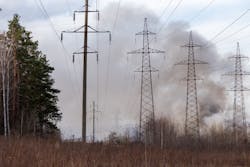Advanced Technologies Complement Traditional Methods for Wildfire Mitigation
Weather trends, the presence of fuel and an ignition source are principal factors that contribute to the start of a wildfire. Statistics from the National Interagency Fire Center (NIFC) recorded 58,950 wildfires, which consumed 10.1 million acres in 2020. Electric utilities are keenly aware of wildfire risk, and wisely are pursuing multiple prevention, detection, and mitigation strategies to improve public safety and power reliability. Tried and true “old-tech” as well as new technologies are on the table when crafting the optimal wildfire mitigation plan.
Bad things are more likely to happen to even the best maintained utility infrastructure and, resultingly, electric service during adverse weather conditions. As a result, utilities are increasingly following or engaging in the business of weather forecasting. Case in point, Pacific Gas and Electric Company (PG&E) recently announced it has completed the installation of 1300 weather stations concentrated in high fire risk areas across its territory. Temperature, wind, and humidity data help utility meteorologists evaluate the potential for severe weather conditions and elevated fire risk in real time. PG&E's Wildfire Safety Operations Center uses the information to inform operational decisions, including the need to enact a public safety power shutoff (PSPS) under extreme conditions.
While in-house weather forecasting is new for most utilities, the business of weather prediction is not. However, the technologies and modelling capabilities utilized have improved dramatically. For example, the NIFC combines weather, soils, vegetation, and other data to produce a wildlands fire potential outlook that provides a four-month prediction of fire risk potential for every section of the country. This information can augment the intel obtained by utilities that are using vegetation management software that identifies vegetation clearances and risk trees along ROWs based on drone, LIDAR, and satellite imagery. Recently, the firm Terrafuse AI announced that it will be offering a free, publicly available data platform that utilizes daily climate information and machine learning predictive models to assess wildfire risk at a highly localized level.
While old school in some respects, vegetation management (VM) is undoubtedly one of the most important contributors to reliability as well as fire risk mitigation. Vegetation can not only initiate sparks or fire by contacting and damaging electric infrastructure, but it also can provide the fuel needed to propagate and intensify fires. Old school methods of VM include tree trimming and mechanical mowing on a cyclic basis. Updated practices include integrated VM programs customized to achieve specific conditions, including low growth, ROW compatible and pollinator friendly plant species that eliminate the need for mowing and frequent tree trimming. Newer techniques include the use of dormant season herbicides that further reduce habitat impacts and granular herbicides that eliminate vegetation growth in limited zones around power poles. One of the latest technology innovations for VM related fire risk reduction is the utilization of near real-time satellite imagery and AI to determine vegetation clearances and growth rates more accurately along power lines; identify danger tree/hazard tree and high-risk areas; plan cycle trim/line clearance; and schedule the use of herbicides and tree growth regulators.
Always important traditional methods for wildfire prevention include visual inspection of lines and equipment for damage, the use of fire protective coatings for wooden poles and the use of covered conductors. In addition, fire rated equipment protectors such as Reliaguard and Greenjacket protect wildlife and reduce fault and fire potential. Increasingly popular strategies include the use of fire-resistant steel and fiberglass poles and crossarms. Priority Wire & Cable Inc. (PW&C) is promoting a fire resistant-non-propagating (FR-NP) covered wire product that reduces the risk that a line fault will cause a secondary fire.
New fire prevention technologies on the scene help utilities detect impending and invisible risks. One example is the use of intelligent line sensors and analytics that enable utilities to detect real-time anomalies such as transient fault currents. PG&E is deploying distribution fault anticipation (DFA) on multiple circuits to detect incipient failures and other line conditions that high fault current detection methods could miss. Used in conjunction with AMI, line sensors and other surveillance techniques, DFA is proving to help provide a more complete overview of distribution system health. Southern California Edison (SCE) is taking another tack using rapid earth fault current limiters (REFCLs) to reduce the risk of ignition by faults involving a single-phase conductor.
Wildfire mitigation has become a very high priority throughout the U.S. and world. Thankfully, proactive utilities, universities and other organizations are constantly identifying new technologies and improvements to traditional mitigation methods. Check out T&D World’s Wildfire Center of Excellence at https://www.tdworld.com/wildfire and the company’s several E-Books with Wildfire Risk Mitigation titles to get updates on this important topic and to learn more about what the companies mentioned above are doing.
About the Author
David Shadle
Grid Optimization Editor
Dave joined the T&D World team as the editor of the Grid Optimization Center of Excellence website in January 2016.
Dave is a power industry veteran with a history of leading environmental and development organizations, championing crucial projects, managing major acquisitions and implementing change. Dave is currently a principal at Power Advance, LLC, an independent consulting firm specializing in power project development, research and analysis, due diligence and valuation support. Dave is also a contributing consultant for Transmission & Distribution World. Prior to Power Advance, Dave held business and power project development positions with The Louis Berger Group, Iberdrola Renewables, FPL Energy and General Public Utilities. He is a graduate of Pennsylvania State University, the New Jersey Institute of Technology and Purdue University.
